Bali is renowned for its pristine beaches, majestic hills, rich culture, luxurious resorts and fancy beach clubs, but it is also blessed with scores of breath-taking waterfalls that are scattered throughout the island. Many of them are easily accessible through a hike or trudge through forests, along trails and among wildlife. Here we invite you to go off the beaten track and discover some of the best waterfalls in Bali.
Going off the beaten track…
Before we share our list of suggested waterfalls on the island, we actually want to encourage you to maybe look for your own waterfall to ‘discover’. You’ll be surprised by just how many waterfalls can be found in Bali.
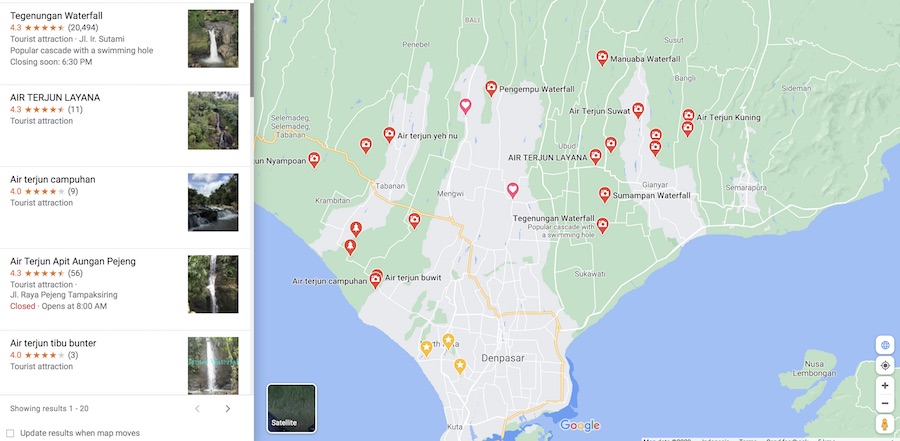
These waterfalls many not be as ‘impressive’ but they offer a chance for you to go off the beaten track and find one less likely to be visited by tourists:-
• Head to Google Maps, make sure your location is on
• Search for the term ‘Air Terjun’
• A list will appear on the left, as well as points on the map.
• If you see one with ideal photos (left panel) or location (map), make sure you read all of the reviews before going.
• Once you’ve decided, start your own little adventure to find a Bali waterfall off the beaten track. Good luck and stay safe!
But if you want to visit Bali’s more well-known spots, here are several of our favourite waterfalls in Bali you should most definitely visit (plus a few lesser known ones!):
CONTENTS
• Waterfalls near Ubud – Gianyar Regency
• Waterfalls near Tabanan Regency
• Waterfalls near Karangasem Regency
• Waterfalls near Buleleng Regency
Waterfalls near Ubud – Gianyar Regency
Tegenungan Waterfall
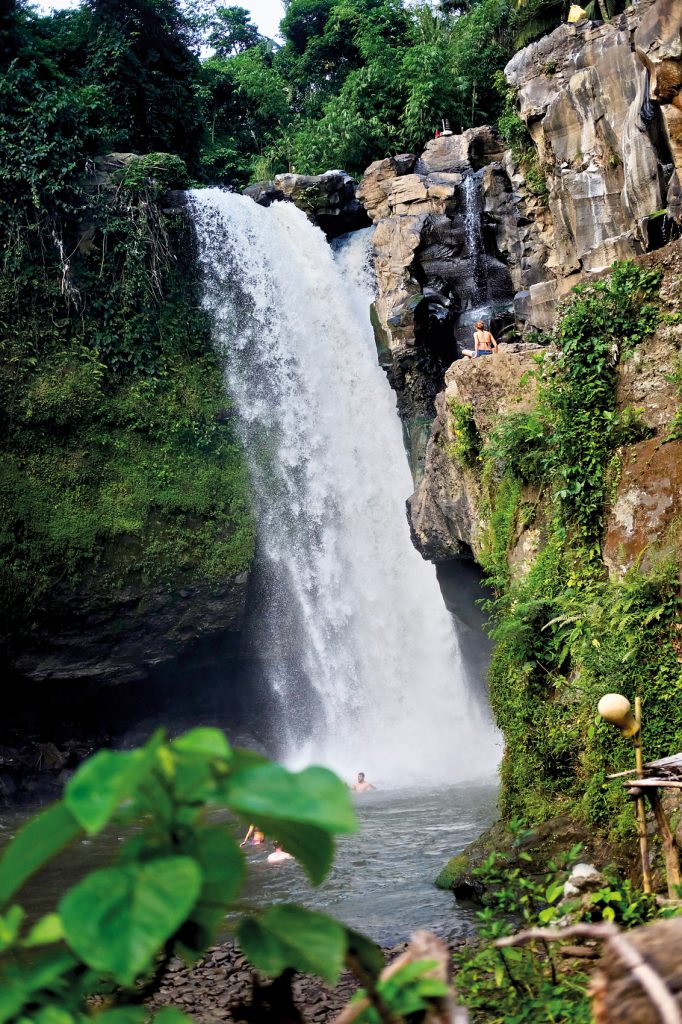
In the tranquil, greater area of Ubud, nestles the equally calming Tegenungan Waterfall. Tegenungan is considered the closest natural attraction of its kind that you can reach within only a 30-minute drive from downtown Ubud, making it the most frequented waterfall in Bali.
Reaching Tegenungan from Ubud or Denpasar is a pleasant drive through paved village roads lined with coconut trees and stretches of green rice paddies on both sides. Upon entering the waterfall area, you’ll find a parking lot and ticket booth; this area is also filled with art and souvenir shops as well as small stalls selling snacks and cold drinks. From here, it only takes several minutes to walk down to the waterfall.
As you walk down the trail and away from the shops, you’ll be greeted by million-dollar views of the green surroundings, with the cascading water as the centrepiece. The waterfall is framed by dense foliage, and the volume of the water is splendid at almost any time of year, though normally at its strongest during the wet season. You can go down to the pebbly base and enjoy a dip in the plunge pool, but this is not advised after heavy downpours, due to the risk of flash floods.
Note that there is now more development and commercialisation around the Tegunungan – this makes it great for convenience, but does take away from the ‘adventure’ experience.
Tukad Cepung Waterfall
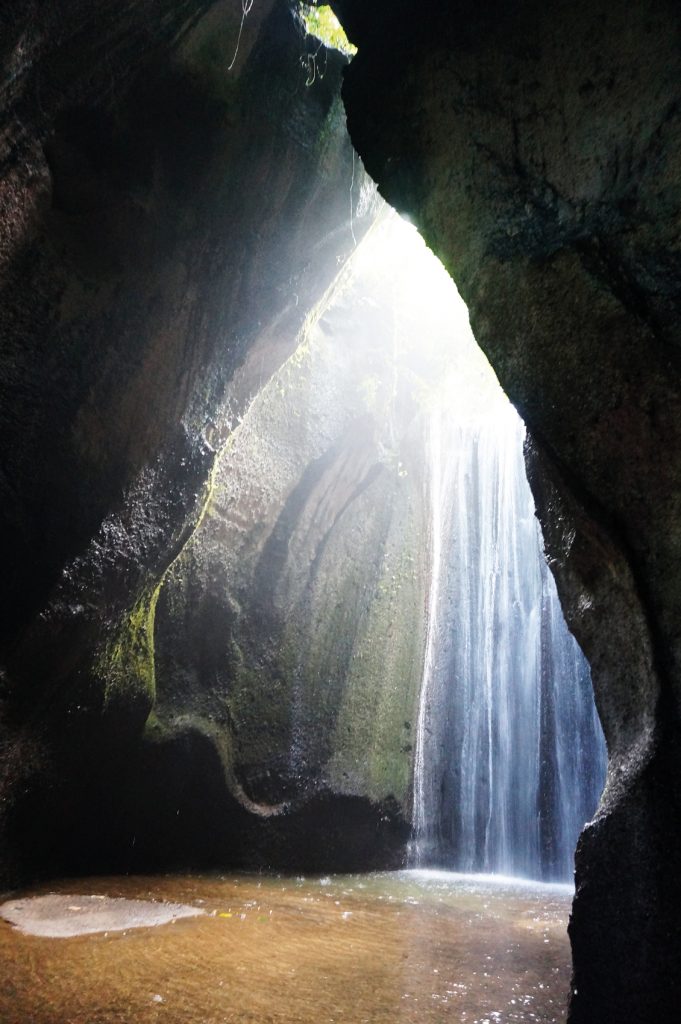
Located 30 kilometres north-west of Ubud, stands a waterfall that should not be missed. If you are coming from Denpasar, you can reach Dusun Penida Kelod in Bangli by car or motorbike in about two hours.
Tukad Cepung Waterfall has mesmerised everyone who has managed to find it. Well-guarded by the cliffs, this waterfall is difficult to locate for the first time visitor. The several hundred steps down the cliff are worth the effort once you arrive at the destination. The circular cliffs give you the feeling of being in a cave, while the open sky right from where the waterfall emerges, gives you an enchanting view. The sunlight falls on the glistering waterfall creating a rainbow, which feels as though it is projected right up to you. If you have never seen water flowing from the sky, then this would be your chance. Unlike any other waterfall in Bali, Tukad Cepung does not flow directly into a river, stream or lake, but flows gently down the cliffs. The source can be seen from up above, but the waterfall can only be viewed once you walk down the stairs and into the cliffs.
Since the water gets accumulated within the cliffs, it gets really deep during the rainy seasons. For that reason, it is not recommended to visit Tukad Cepung Waterfall during the monsoon season. But during other seasons, you can stand and observe the water calmly flowing down and making a narrow stream inside the cliff. This place is comparatively cooler and offers an immense sense of peace and tranquillity.
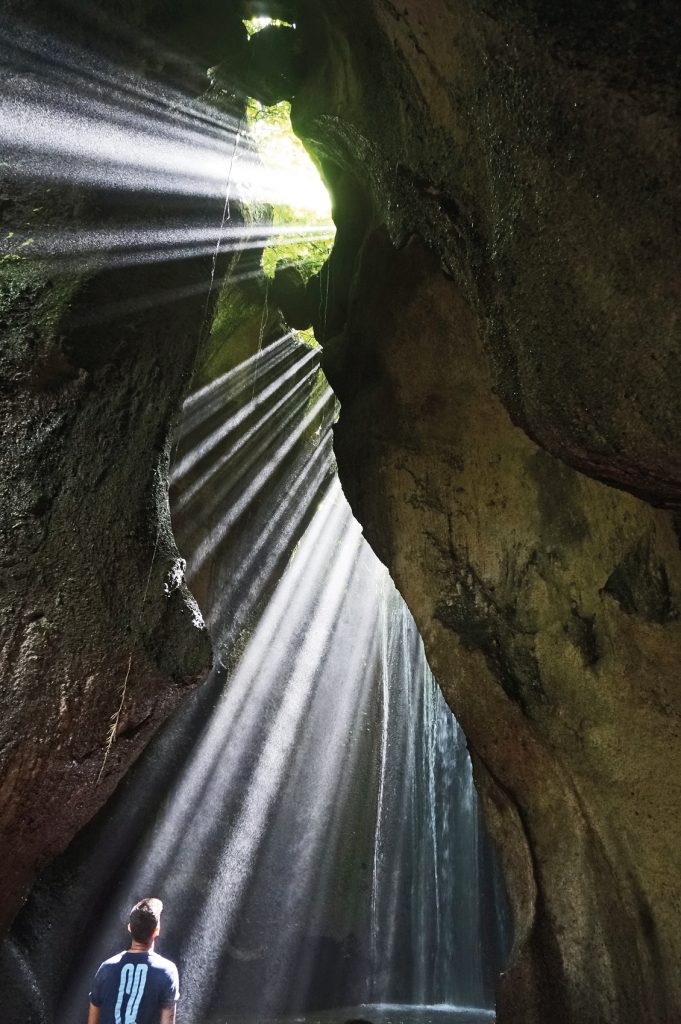
Here you can take a shower under the waterfall, enjoy a picnic on top of the surrounding huge rocks, swing with the lianas hanging down through the jungle-like area or kick off a yoga session to feel the freedom! This place is so photogenic that you might encounter “Instagramers” taking shots from a million different angles and poses.
Manuaba Waterfall
Located in Kenderan Village, about 9 km or a 20-minute drive from Central Ubud, Manuaba Waterfall is one of the must-visits in the area. You can find this waterfall through a 15-minute walk from the nearby Griya Sakti Temple. Getting to the location is quite easy and it takes very little effort without having to through extreme ravines.
This waterfall features several uniqueness including the presence of an old cave in the local village named Yeh Daha Cave, which is located at the southwestern end of the waterfall. The water at Manuaba Waterfall comes from different sources with seven tributaries feeding into the waterfall. These tributaries are holy springs or “tirta”, namely Tirta Sangku, Tirta Sudamala, Tirta Sambung Dawa, Tirta Bulan, Tirta Dadapan, Tirta Grinsing and Tirta Lindung Wesi. It is believed that Manuaba Waterfall emits a holy aura and healing powers for those who believe it.
The calm and quiet atmosphere as well as the verdant natural surroundings of the waterfall presents more privacy that will certainly delight anti-mainstream nature lovers seeking a tranquil experience. The discharge of the waterfall is quite heavy, but during the dry season the water flow tends to be smaller. The waterfall stands around 10 meters, flowing and plunging between cliffs that are not too high. The waterfall flows swiftly between the rocky cliffs, while the shrubs and green moss thrive in this area. A shallow natural pool is formed under the waterfall with rocks surrounding the reservoir.
Waterfalls near Tabanan Regency
Yeh Hoo Waterfall
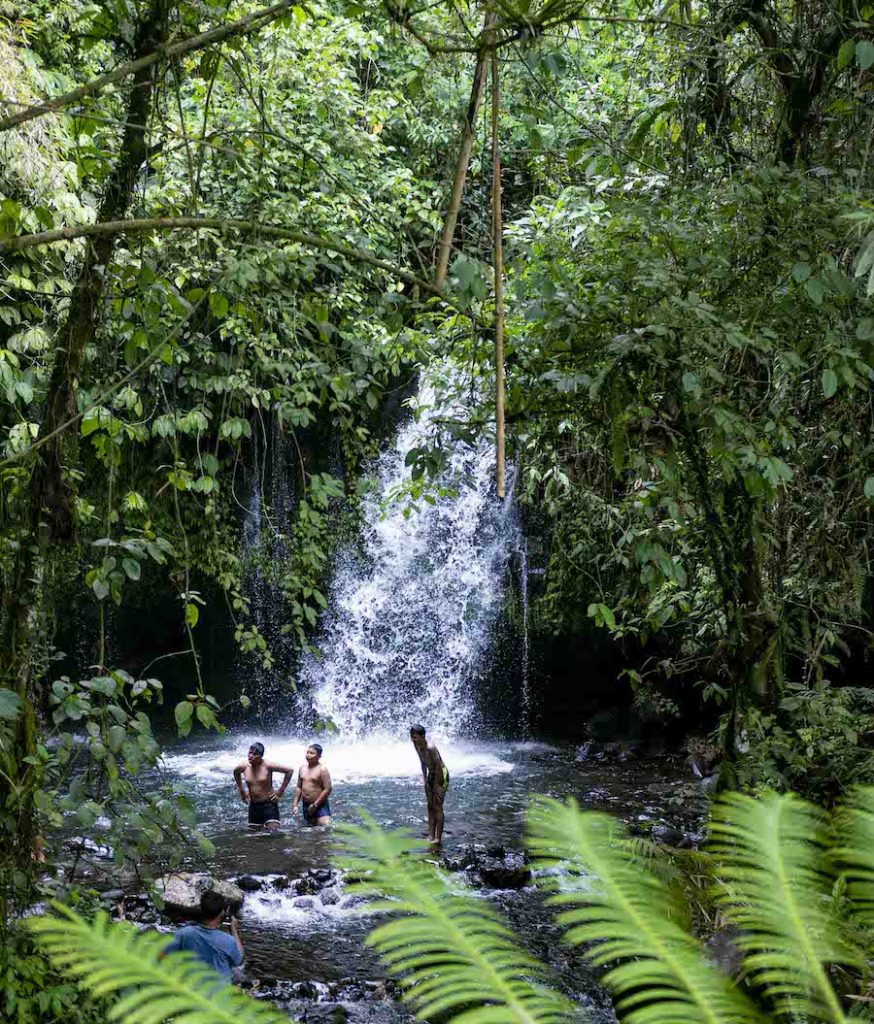
Located in Jatiluwih Village, in the Tabanan Regency, is Yeh Hoo Waterfall, known locally as Giri Kusuma Waterfall. It can be found north of the city of Tabanan, about 46 kilometres or less than 1.5 hours away from Denpasar. Although Yeh Hoo Waterfall is not as popular as the terraced rice fields that Jatiluwih is known for, the existence of this natural waterfall has been around for a long time. Despite its strategic location at one of the most popular tourist destinations in Bali, not many know about the existence of this waterfall because of its hidden location behind a local moor.
However, thanks to the power of social media, Yeh Hoo Waterfall is starting to attract local visitors who come to witness the beauty of this waterfall. Yeh Hoo Waterfall is around 8 metres tall, which is not that high compared to other waterfalls in Bali, but the water discharge coming from mountain springs is quite heavy. The water at the bottom of the waterfall is clear, making it a nice place to take a dip in the fresh mountain water.
Getting to the waterfall is a breeze, from the parking lot you’ll only need to climb down a flight of stairs that will take you approximately 5 minutes. During the short walk, you’ll be able to enjoy the mesmerising natural beauty and the serenading sounds of chirping birds and buzzing insects. If you’re planning a tour of Jatiluwih, Yeh Hoo Waterfall will definitely be one of the highlights of that tour.
Note that Yeh Hoo is considered holy by locals, who come to the nearby temple to pray – and sometimes cleanse in the waterfall. You’re welcome to swim here, but please be respectful.
Waterfalls near Karangasem Regency
Jagasatru Waterfall
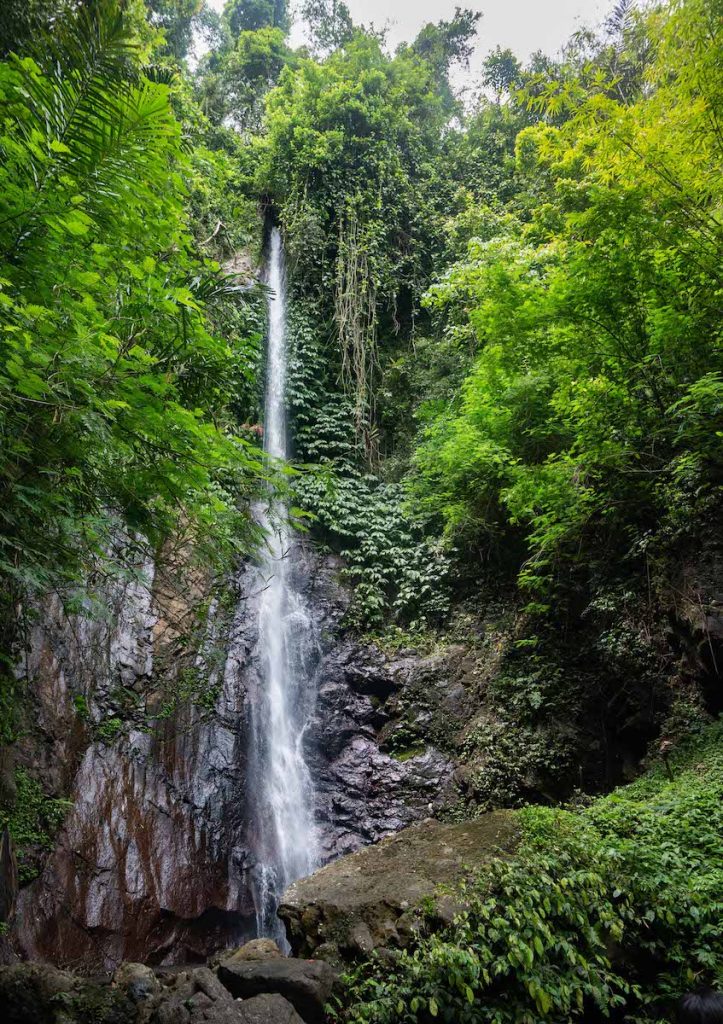
Located in the eastern region of Bali, Jagasatru Waterfall can be found in East Duda Village, in the Karangasem Regency, around 55 kilometres or 1½ hours away from Denpasar. The beauty of Jagastaru Waterfall will definitely charm visitors into staying at the waterfall for hours, this majestic waterfall stands 40 metres tall above ground level. Its location is quite hidden and not as easily accessed, which is why not a lot of people have heard about it yet. This naturally-formed waterfall is well-known among the local residents but only recently tourists, thanks to the presence of social media.
Flanked between two high cliffs and enclosed within verdant trees and bushy groves, Jagasatru Waterfall is indeed one of the most beautiful waterfalls in Bali that boasts a calm and peaceful atmosphere. The waterfall has a strong spiritual aura, perhaps as a result of its distance from settlements, which makes it a great place for meditation, contemplation, to be closer to nature and admire its beauty. The source of the waterfall comes from a mountain spring, although its discharge is not that forceful.
Jagastaru Waterfall is suitable for those who enjoy a little bit of adventure because you’ll have to trek through 1km of steep hilly roads to get to the waterfall. However, the extra effort will all pay off once you get to the waterfall.
Note those driving to Jagastaru must note that the roads are very steep and extremely difficult to navigate. We highly advise you to park under the village area before the winding roads down to the waterfall.
Waterfalls near Buleleng Regency
Quick tip for those in the Munduk or even Bedugul area, looking for waterfalls: There is in fact a whole row of them you can find if you simply drive down ‘Jalan Raya Pancasari – Jalan Raya Wanagiri’, the road that lines above the twin lakes of Tamblingan and Buyan.
On one side of the road you will see the viewpoints and the small bales that look out to the lakes, on the other side many small roads branch off down the ridge and waterfall entrances are advertised there. Simply follow the signs to your chosen waterfall!
Munduk Waterfall
Located in the northern region of Bali, Munduk Waterfall nestles in Munduk Village, in the Buleleng Regency, around 62 kilometres or about 1 hr 40 minutes away from Ubud. Standing 800 metres above sea level, a journey to this waterfall provides the refreshing cool breeze and green scenery of the Bali highlands. Visitors, especially trekking lovers, will surely enjoy the outing to this waterfall as they’ll be graced with scenic views of clove and coffee plantations along the way, making the journey seem effortless until you reach the splashing beauty of Munduk Waterfall.
An untouched natural waterfall, Munduk Waterfall stands 15 metres tall with the water discharge from above giving the ultimate refreshing sensation. At the bottom of the waterfall, a fairly expansive natural pool is formed with a sloping and non-rocky landscape, making it an idyllic place for visitors to jump in for a dip. The waterfall is flanked by towering cliffs adorned with trees and plants typical of mountains, adding to the breath-taking scenery of the waterfall.
The water that flows from Munduk Waterfall contains minerals including sulfur, which has many benefits including relieving various skins diseases and skin rejuvenation. This results in many visitors coming to the waterfall to play, bathe and swim in the natural pool.
Banyumala Twin Waterfalls
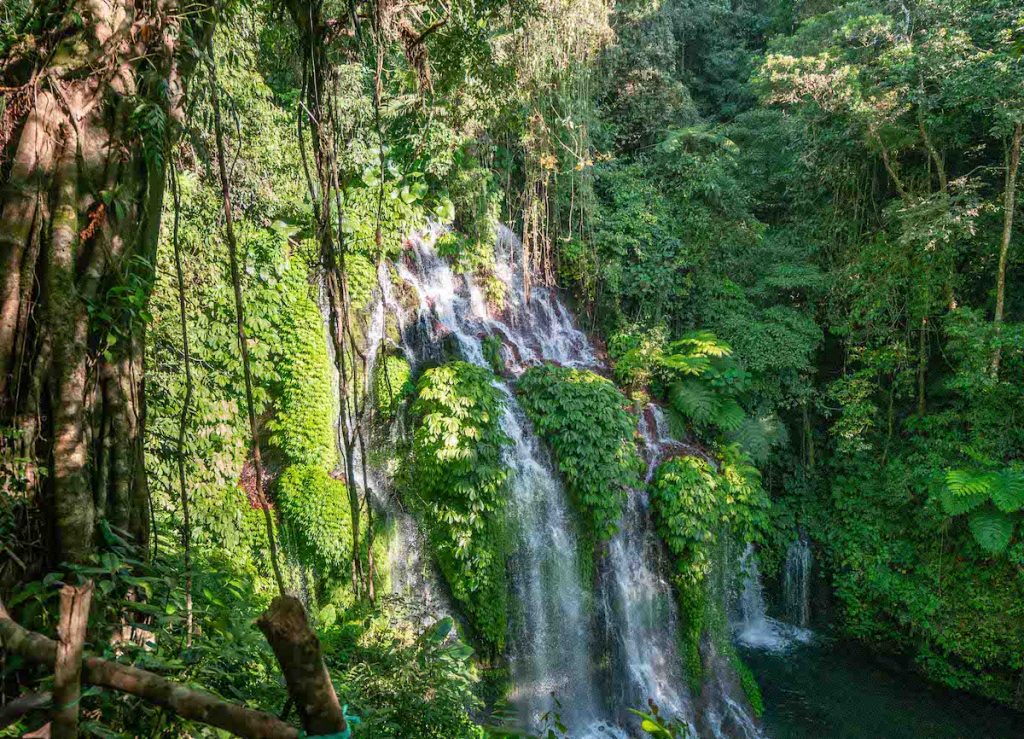
A journey to northcentral Bali will take you to Banyumala Twin Waterfalls, located north of Lake Buyan, in the Wanagiri Village of Buleleng Regency. It is approximately 57 kilometres or 1.5 hours away from Ubud. As one of the best tourist attractions in the Buleleng Regency, this unique destination boasts natural charm with its untouched beauty and tranquillity away from the crowd, which makes it one of the must-visits in North Bali. A hidden gem in Bali, this destination is managed by the local residents.
The path to the waterfalls is quite easy and accessible, though it’s a little bit steep because of its location at the bottom of a valley. Once you’ve arrived at the parking lot, you’ll need to walk about 150 metres to the guard post to purchase an entrance ticket. From there, you’ll need to walk another 200 metres, where the path will start to descend to the location. You’ll also have to climb down a 3-metre bamboo ladder before finally arriving at Banyumala Twin Waterfalls. Its location at the bottom of the valley makes the downhill trek a bit extreme but what awaits you at the final destination is worth the effort.
The surrounding scenery is magical, with the refreshing breeze from the waterfall discharge presenting a rejuvenating ambience. A natural pool is formed at the bottom of the waterfalls, where visitors can take a dip and soak in the freshwater freely. The fresh water coming from the mountain springs is crystal clear, while the natural rocks that form the cliffs frame the waterfalls so beautifully. The uniqueness of this natural attraction is the main waterfall in the middle, which is split into two streams with overgrown trees and shrubs where it’s split.
Aling-Aling Waterfall
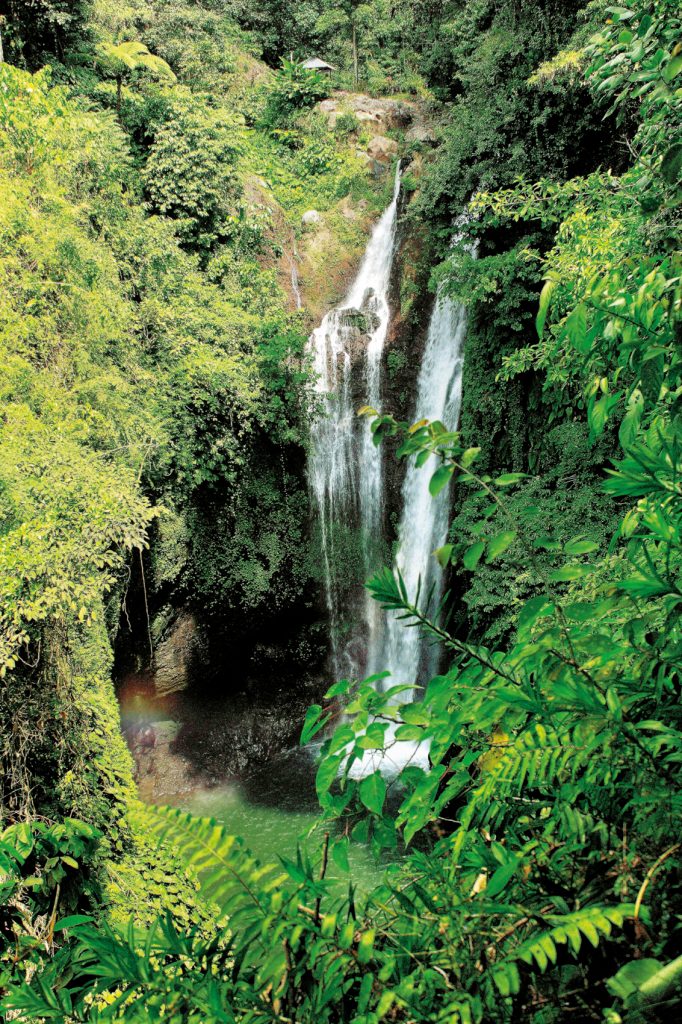
Located in the northern regions of Bali, Aling-Aling Waterfall is found in Sambangan Village, Buleleng Regency, 11 kilometres from the old northern capital of Singaraja. It is around 3 hours away from Denpasar. It is an oasis of unspoiled nature, one that will take your breath away – definitely one of the best waterfalls in Bali.
Adventure junkies will enjoy the opportunity to cliff jump into the plunge pools at Aling-Aling. From 5, 10 or 15 metres high, take a leap of faith to get the adrenalin going. Those who are afraid of heights can also opt to slide down a natural waterslide made from years of natural erosion of the cliff rocks. Paddles and swims in the basin of the waterfall are possible for those just looking for a quick dip in the fresh mountain river waters.
When you arrive, you may be daunted by the path down to the waterfall as rewards usually come after hard work! A tiring walk down hundreds of stone steps, about 400 metres down, is what separates you and Aling-Aling. While the descent down is tiring, like Tukap Cepung, the scene that awaits for you is worth the effort. You’ll be greeted with a magnificent view of the towering falls, 35 metres high falling from a steep cliff and surrounded by lush greenery as well as rice fields. The water that gushes from the falls are crystal clear, and the surrounding air is cool and refreshing as the mist sprays towards you.
If you look closely at Aling-Aling Waterfall, one can see that the giant cascading feature is in fact one huge flow of water separated into two adjacent falls. The fall on the right-hand side falls with formidable speed, volume and force, creating a thunderous crash as the water meets the plunge pool below. The rumble of the falling water adds life to the surrounding area so it is no wonder that Aling-Aling is on the list of favourites amongst photographers and shutterbugs alike.
Gitgit Waterfall
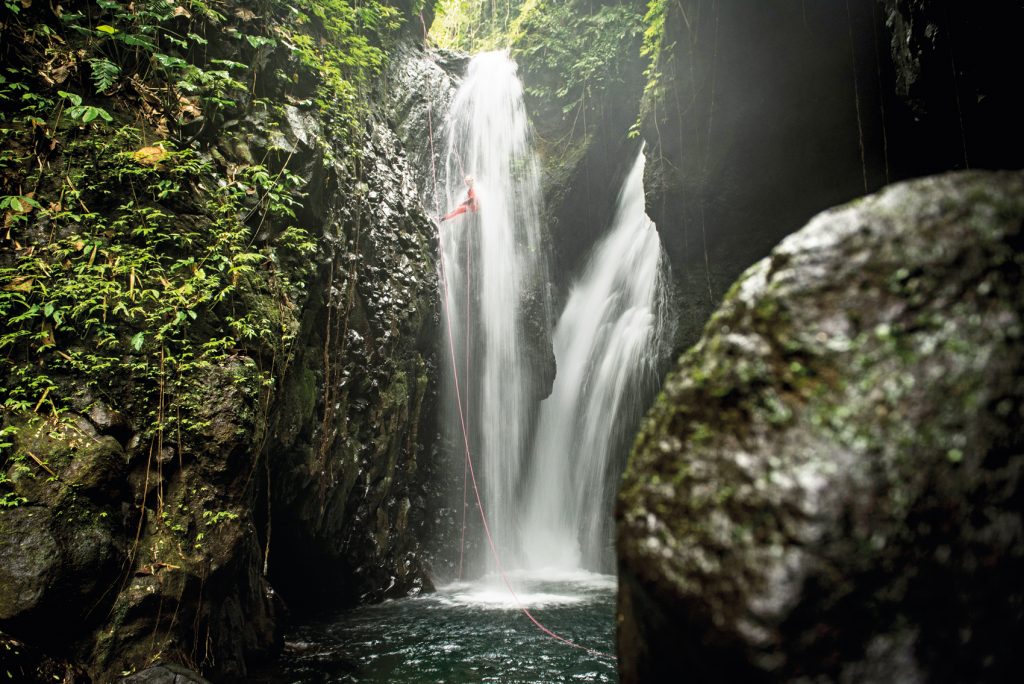
One of the most famous waterfalls in north Bali, Gitgit is located in the plateau area with a height of about 45 metres. It’s the first waterfall you’ll find upon entering the Gitgit Village in Buleleng regency.
Gitgit is surrounded by dense tropical trees with some plantations protecting the rain forest around it. The walk to this waterfall is a long downhill trek. From the parking area, take a 500-metre scenic walk, along the way you can find some of the island’s common plants, such as cacao, coffee, clove and nutmeg. With paddy fields on your left and a green canyon on your right, your walk to the waterfall is invigorating. The sound of the waterfall can be heard from 200 metres away – mixing nicely with the chirping birds – and after a few more steps you can see the huge cascades of gushing water descending from 45metres and hitting the water and the big stones below.
Sekumpul Waterfall
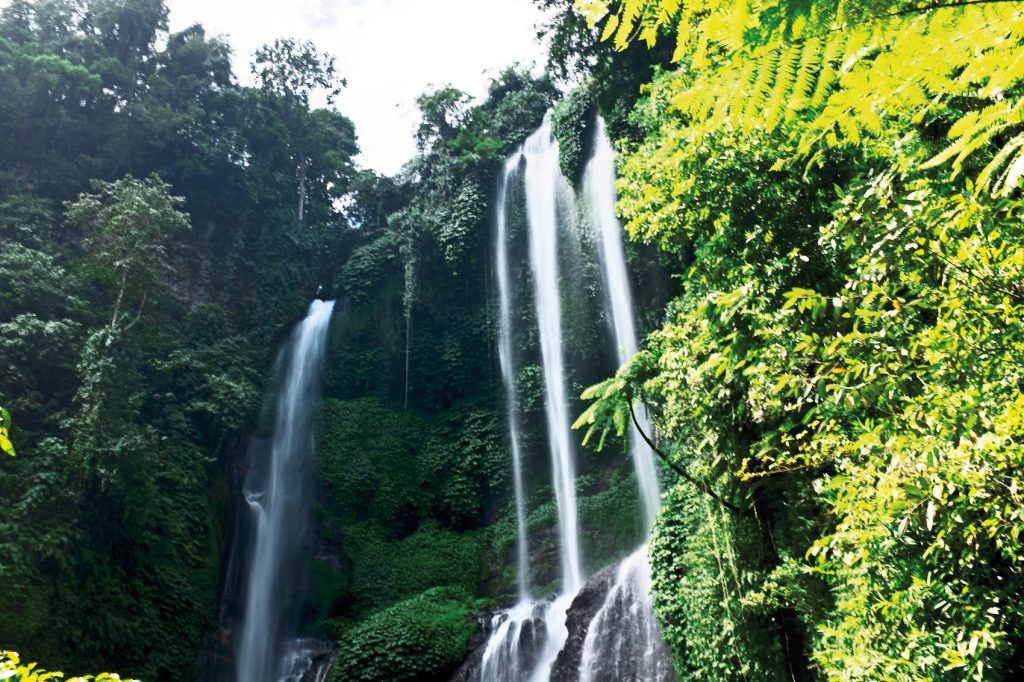
Meaning “a group of”, Sekumpul is actually a cluster of seven waterfalls. Located in the village of Sekumpul in an upland area of the Buleleng regency. The waterfall is within an hour’s drive southeast from Lovina Beach. The falls are fed by two mountain streams and the main one, the one referred to as the Sekumpul Waterfall, is the most accessible of the collection of falls in the area. When thinking of the best waterfalls in Bali, Sekumpul often comes to mind.
Sekumpul is surrounded by a lush, green bamboo forest. Going down to the waterfall, you’ll go through dirt tracks, down hundreds of steps, and cross over shallow streams. There are two available tracks for you to reach the waterfall. The first one is a trek that leads you to purpose-built gazebos, a stopping point for you to cool down and catch your breath while enjoying the view of the 80m-tall majestic fall from a distance. The other one is a forest and village trail that leads you down to the rock pool base of the falls, which includes traversing down more steps through a combination of rice paddies, durian, rambutan and coffee plantations. The breathtaking natural beauty here will seduce any nature lover, landscape photographer, and those with a knack for adventure.










